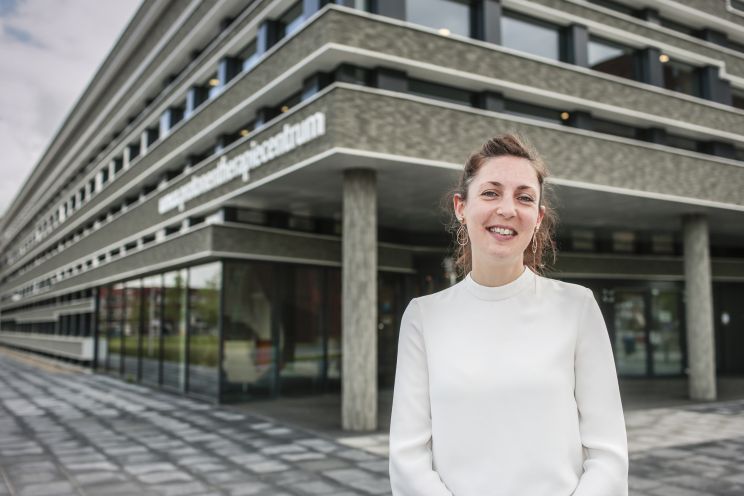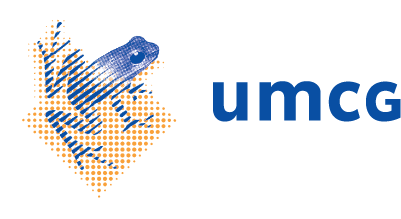Proton therapy, moving tumors and a vision
3 July 2018
By Perrie Hoekstra, UMCG Polsslag.
The UMCG proton therapy center was officially opened in June this year. It is the first such center in the Netherlands, used in the treatment of cancer patients. Researchers at the center, such as Antje Knopf, aim to further improve this technique. “I always have time to talk about my research.”
Antje immediately apologizes for her less than perfect mastery of the Dutch language. But she speaks with great enthusiasm about her research, the UMCG and the opportunities that arise from its focus on research. Her specialism is proton therapy for the treatment of moving tumors. Treatment of such tumors starts next year.
“The lungs are a very radiation sensitive organ and tumors within the lungs are often located in close proximity to other vital organs as well, such as the heart,” says Antje Knopf. “To make things worse, these tumors move as a result of patient breathing. This motion varies between patients. In my research I aim to minimize the risk of radiating healthy tissues.”
A dream job
She had wanted to become an astronomer, but that study turned out to be very theory-oriented at Heidelberg University. Physics in medicine, and especially its role in the well-being of humans, was much more to her liking. Protons became the main theme of her career. After completing her studies, she acquired a PhD in Boston. She also worked and lived in Japan, Switzerland and London before running into her dream job, two years ago. “A full-time research position in my area of expertise. It’s an opportunity you only get once every fifteen years or so. The UMCG offered me exactly such a position.” She traded London for Groningen.
A safer treatment
“At the UMCG, we already treat lung cancer patients with photons. We have a lot of knowledge related to the motion of these tumors. We have images of their exact shape and location, and their motion pathway. We load all this information into a computer program that allows us to simulate the proton therapy treatment and to determine the risks of such treatment. It provides us insight into the radiation received by healthy tissues and vital organs.
Based on these simulations we develop strategies towards a safer treatment. This could also mean that, for certain patients, we decide to treat with photons rather than protons. One of the goals of my research is to support such a choice.
Multiple vocabularies
In her research, Antje collaborates with computer programmers, biomedical engineers and, of course, physicians. “They all have their own specific vocabulary. It is very important to make sure you fully understand each other. We therefore organize many multidisciplinary meetings, allowing each professional to explain their wishes and problems.”
The proton center is nearly always in use for the treatment of patients, leaving little opportunity for Antje to perform experiments in the treatment rooms. “We can’t interfere with patient treatments. But the KVI Center for Advanced Radiation Technology is located on the Zernike Campus. They have their own cyclotron producing high-energy protons, allowing me to perform my experiments. Groningen is the perfect place for proton therapy research.”
London
Before coming to Groningen, Antje made a brief sidestep into ‘traditional’ photon therapy. For two years she worked at the Institute for Cancer Research in London, focusing on a Dutch invention: a machine combining photon therapy with an MRI-scanner.
“Such a machine offers real-time visualization of the treatment. If you notice that you are not irradiating the tumor, but healthy tissue, you can halt the treatment.” What limits the use of this machine is the fact that it is difficult to steer photons with high accuracy.
This makes the combination of an MRI with proton therapy a very promising development. “You can steer protons with millimeter accuracy, especially if you have real-time visual information related to the geometry of the tumor and the patient. Building such a machine is the dream I want to realize here, in Groningen. Succeeding would be great news for patients.”
Ten years
She thinks that it will take ten years, and a lot of money, to develop this combination of an MRI with proton therapy. Groningen is the perfect place, again, says Antje. “I am very happy with the Grant Support Hub. A research proposal easily consists of 50 pages or more, and there are many judicial aspects as well. I receive excellent support.”
 Antje Knopf in front of the UMCG proton therapy center. (Photo: Henk Veenstra)
Antje Knopf in front of the UMCG proton therapy center. (Photo: Henk Veenstra)

 English
English
 Nederlands
Nederlands